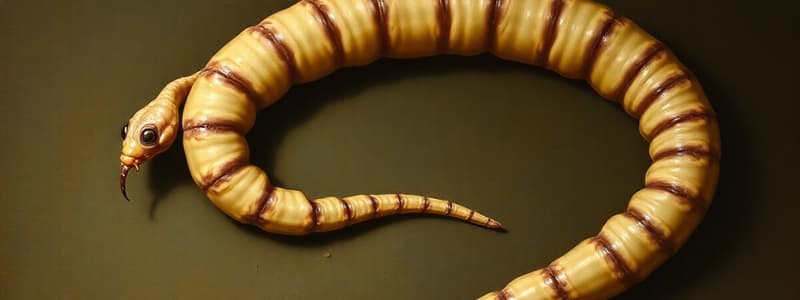Podcast
Questions and Answers
What is the Phylum and Class for tapeworms like Taenia and Diphyllobothrium?
What is the Phylum and Class for tapeworms like Taenia and Diphyllobothrium?
Phylum: Platyhelminthes, Class: Cestoda
Cestodes possess a complete gastrointestinal tract.
Cestodes possess a complete gastrointestinal tract.
False (B)
Most cestodes are monoecious, meaning they have both male and female reproductive organs.
Most cestodes are monoecious, meaning they have both male and female reproductive organs.
True (A)
Match the Cestode order with its characteristic feature:
Match the Cestode order with its characteristic feature:
What are the three main body parts of a typical Cyclophyllidean tapeworm?
What are the three main body parts of a typical Cyclophyllidean tapeworm?
Which part of the cestode strobila contains the reproductive structures?
Which part of the cestode strobila contains the reproductive structures?
What is the common name for Taenia saginata?
What is the common name for Taenia saginata?
What is the common name for Taenia solium?
What is the common name for Taenia solium?
What is the intermediate host for Taenia saginata?
What is the intermediate host for Taenia saginata?
What is the intermediate host for Taenia solium?
What is the intermediate host for Taenia solium?
What is the infective stage of Taenia saginata for humans?
What is the infective stage of Taenia saginata for humans?
What are the two infective stages of Taenia solium for humans?
What are the two infective stages of Taenia solium for humans?
How are humans infected with Taenia saginata or Taenia solium (intestinal infection)?
How are humans infected with Taenia saginata or Taenia solium (intestinal infection)?
What is the typical length range for an adult Taenia saginata?
What is the typical length range for an adult Taenia saginata?
What is the typical length range for an adult Taenia solium?
What is the typical length range for an adult Taenia solium?
How can gravid proglottids of Taenia saginata and Taenia solium be differentiated?
How can gravid proglottids of Taenia saginata and Taenia solium be differentiated?
Taenia saginata eggs are morphologically distinct from Taenia solium eggs.
Taenia saginata eggs are morphologically distinct from Taenia solium eggs.
What disease does the adult Taenia saginata or Taenia solium cause in humans?
What disease does the adult Taenia saginata or Taenia solium cause in humans?
What disease does the larval stage of Taenia solium cause in humans?
What disease does the larval stage of Taenia solium cause in humans?
What is the specimen of choice for diagnosing Taeniasis?
What is the specimen of choice for diagnosing Taeniasis?
What technique can be used to visualize the uterine branches in Taenia proglottids?
What technique can be used to visualize the uterine branches in Taenia proglottids?
What diagnostic methods are used for Neurocysticercosis?
What diagnostic methods are used for Neurocysticercosis?
Taeniasis solium (adult worm infection) is more dangerous than Cysticercosis (larval infection).
Taeniasis solium (adult worm infection) is more dangerous than Cysticercosis (larval infection).
What is the primary treatment drug for Taeniasis (both T. saginata and T. solium)?
What is the primary treatment drug for Taeniasis (both T. saginata and T. solium)?
What is the common name for Hymenolepis nana?
What is the common name for Hymenolepis nana?
What is the common name for Hymenolepis diminuta?
What is the common name for Hymenolepis diminuta?
What are the typical intermediate hosts for Hymenolepis diminuta?
What are the typical intermediate hosts for Hymenolepis diminuta?
Hymenolepis nana always requires an intermediate host.
Hymenolepis nana always requires an intermediate host.
What is the infective stage of Hymenolepis nana for direct human infection?
What is the infective stage of Hymenolepis nana for direct human infection?
What is the infective stage of Hymenolepis diminuta for humans?
What is the infective stage of Hymenolepis diminuta for humans?
Describe a key difference between the eggs of Hymenolepis nana and Hymenolepis diminuta.
Describe a key difference between the eggs of Hymenolepis nana and Hymenolepis diminuta.
Describe a key difference between the scolex of Hymenolepis nana and Hymenolepis diminuta.
Describe a key difference between the scolex of Hymenolepis nana and Hymenolepis diminuta.
Autoinfection is a common feature of Hymenolepis diminuta infections.
Autoinfection is a common feature of Hymenolepis diminuta infections.
Which Hymenolepis species is considered the most common tapeworm recovered in the U.S.?
Which Hymenolepis species is considered the most common tapeworm recovered in the U.S.?
What is the treatment for both Hymenolepis nana and Hymenolepis diminuta infections?
What is the treatment for both Hymenolepis nana and Hymenolepis diminuta infections?
What are the common names for Dipylidium caninum?
What are the common names for Dipylidium caninum?
What is the typical intermediate host for Dipylidium caninum?
What is the typical intermediate host for Dipylidium caninum?
How do humans typically become infected with Dipylidium caninum?
How do humans typically become infected with Dipylidium caninum?
What is the characteristic diagnostic stage found in stool for Dipylidium caninum infections?
What is the characteristic diagnostic stage found in stool for Dipylidium caninum infections?
Describe the appearance of a gravid proglottid of Dipylidium caninum.
Describe the appearance of a gravid proglottid of Dipylidium caninum.
What is the treatment of choice for Dipylidium caninum infection?
What is the treatment of choice for Dipylidium caninum infection?
What are common names for Echinococcus granulosus?
What are common names for Echinococcus granulosus?
What is the definitive host for Echinococcus granulosus?
What is the definitive host for Echinococcus granulosus?
What are the typical intermediate hosts for Echinococcus granulosus?
What are the typical intermediate hosts for Echinococcus granulosus?
How do humans become infected with Echinococcus granulosus?
How do humans become infected with Echinococcus granulosus?
What is the infective stage of Echinococcus granulosus for humans?
What is the infective stage of Echinococcus granulosus for humans?
What is the diagnostic stage of Echinococcus granulosus in humans?
What is the diagnostic stage of Echinococcus granulosus in humans?
What disease does the larval stage of Echinococcus granulosus cause in humans?
What disease does the larval stage of Echinococcus granulosus cause in humans?
Echinococcus granulosus is the longest tapeworm found in humans.
Echinococcus granulosus is the longest tapeworm found in humans.
Where do hydatid cysts primarily develop in humans?
Where do hydatid cysts primarily develop in humans?
What is 'hydatid sand'?
What is 'hydatid sand'?
What are the potential consequences of a hydatid cyst rupturing within the host?
What are the potential consequences of a hydatid cyst rupturing within the host?
What are the main treatment approaches for human hydatid disease?
What are the main treatment approaches for human hydatid disease?
What is the common name for Diphyllobothrium latum?
What is the common name for Diphyllobothrium latum?
What type of attachment organs does Diphyllobothrium latum possess?
What type of attachment organs does Diphyllobothrium latum possess?
How many intermediate hosts are required in the life cycle of Diphyllobothrium latum?
How many intermediate hosts are required in the life cycle of Diphyllobothrium latum?
What is the first larval stage of Diphyllobothrium latum that emerges from the egg in water?
What is the first larval stage of Diphyllobothrium latum that emerges from the egg in water?
What is the larval stage of Diphyllobothrium latum found in the first intermediate host (copepod)?
What is the larval stage of Diphyllobothrium latum found in the first intermediate host (copepod)?
What is the infective larval stage of Diphyllobothrium latum for humans, found in the second intermediate host (fish)?
What is the infective larval stage of Diphyllobothrium latum for humans, found in the second intermediate host (fish)?
What is the characteristic appearance of the uterus in a gravid Diphyllobothrium latum proglottid?
What is the characteristic appearance of the uterus in a gravid Diphyllobothrium latum proglottid?
Diphyllobothrium latum eggs are embryonated when passed in feces.
Diphyllobothrium latum eggs are embryonated when passed in feces.
What distinctive feature is found on the Diphyllobothrium latum eggshell?
What distinctive feature is found on the Diphyllobothrium latum eggshell?
What nutritional deficiency can sometimes be associated with Diphyllobothrium latum infection?
What nutritional deficiency can sometimes be associated with Diphyllobothrium latum infection?
What is the treatment for Diphyllobothrium latum infection?
What is the treatment for Diphyllobothrium latum infection?
What is the primary mode of prevention for Diphyllobothrium latum infection?
What is the primary mode of prevention for Diphyllobothrium latum infection?
Flashcards
Cestodes General Characteristics
Cestodes General Characteristics
Flat and ribbon-like, segmented worms, typically white or yellowish in color. They possess both male and female reproductive organs, covered by tegument.
Cestode Infection
Cestode Infection
Human infection starts by consuming raw or undercooked beef (T. saginata) or pork (T. solium) contaminated with cysticercus larva, adult worms emerge and produce eggs.
Cysticercosis
Cysticercosis
Caused by Taenia solium larvae, accidental ingestion of eggs that can spread to other organs. This can be very dangerous.
Taenia Saginata
Taenia Saginata
Signup and view all the flashcards
Taenia solium
Taenia solium
Signup and view all the flashcards
Taenia Diagnosis
Taenia Diagnosis
Signup and view all the flashcards
Hymenolepis nana Eggs
Hymenolepis nana Eggs
Signup and view all the flashcards
Hymenolepis nana Epidemiology
Hymenolepis nana Epidemiology
Signup and view all the flashcards
Hymenolepis nana Symptoms
Hymenolepis nana Symptoms
Signup and view all the flashcards
Hymenolepiasis
Hymenolepiasis
Signup and view all the flashcards
Hymenolepis diminuta MOT
Hymenolepis diminuta MOT
Signup and view all the flashcards
Dipylidium caninum Eggs
Dipylidium caninum Eggs
Signup and view all the flashcards
Dipylidium caninum Hosts
Dipylidium caninum Hosts
Signup and view all the flashcards
Echinococcus granulosus Treatment
Echinococcus granulosus Treatment
Signup and view all the flashcards
Diphyllobothrium latum Scolex
Diphyllobothrium latum Scolex
Signup and view all the flashcards
Diphyllobothrium latum Life Cycle
Diphyllobothrium latum Life Cycle
Signup and view all the flashcards
Echinococcus: hydatid cyst/hydatid disease/hydatidosis
Echinococcus: hydatid cyst/hydatid disease/hydatidosis
Signup and view all the flashcards
Diphyllobothrium Diagnosis
Diphyllobothrium Diagnosis
Signup and view all the flashcards
Diphyllobothrium Symptoms
Diphyllobothrium Symptoms
Signup and view all the flashcards
Study Notes
- Flat, ribbon-like segmented worms
- They are hermaphroditic, but usually need the opposite sex for reproduction
- They have a well-developed reproductive system, tegument, testes, ovaries and uterus for entry/exit of nutrients
Taxonomy
- Platyhelminthes phylum class Cestoda includes Pseudophyllidea and Cyclophyllidea and Trematoda
Cestodes
- Pseudophyllidea and Cyclophyllidea are Flukes.
Larval Stage
- Pseudophyllidea has ovum, coracidium, oncosphere, procercoid and plerocercoid stages
- Cyclophyllidea has ovum, hexacanth oncosphere, oncosphere, cysticercus and cysticercoid stages.
General Characteristics of Pseudophyllidea
- Requires two intermediate hosts and bothria
Cyclophyllidea
- Has acetabula (suckers), possesses a rostellum (armed/unarmed) and 3 main parts
Segments
- Immature segments are nearest to the neck
- Mature segments in the middle, possessing reproductive structures
- Gravid/ripe segments are farthest from the neck and filled with eggs in the uterus that can be detached through apolysis
Life Cycle Notes
- Human infection starts from consuming raw or undercooked beef (T. saginata) or pork (T. solium) contaminated with cysticercus larva
- Adult worms emerge, attach to mucosa and self-reproduce
T. solium Organism
- Can grow 1.5 to 8m long
- Can produce >1000 proglottids each containing 50,000 eggs
T. saginata Organism
- Can grow 4-12m long
- Can contain 1000 to 2000 segments, and produce 100,000 eggs
- Usually one adult is present in T. saginata infections.
- Irritation can be caused by alcohol
- The adult may be irritated by alcohol, with proglottids sometimes resulting after a drinking bout.
- Cows or pigs consume appropriate contaminated eggs and then infective cysticercus larva form.
Taenia Spp
| Taenia saginata | Taenia solium | |
|---|---|---|
| Common Name | Beef tapeworm | Pork tapeworm |
| Intermediate Host | Cattle | Pigs |
| Definitive Host | Humans | Humans |
| Infective Stage | Cysticercus bovis | Cysticercus cellulosae and embryonated egg |
| Mode of Transmission | Ingestion of infected uncooked/raw beef | Ingestion of measly pork and embryonated egg |
| Diagnostic Stage | Embryonated egg | Embryonated egg |
| Habitat | Small intestine | Small intestine |
| Length (adult) | 4-10m (up to 25m) | Less than 7m (2-4m) |
| Lateral branches | Longer than wide (16-20mm by 5-7mm) | Wider than tall has 15 lateral branches |
| Eggs | Spherical or subspherical shape (30 to 45 um in diameter) | Spherical or subspherical shape (30 to 45 um in diameter) |
| Pathology | Taeniasis | Taeniasis (due to adult), Cysticercosis (due to larva) |
Eggs
- Spherical, striated, embryonated, and contains 6 hooklets
- Motile, called 1st stage larva (due to their motility/movement)
Diagnosis
- Stool sample is test of choice for eggs and gravid proglottids
- The scolex is only seen after treatment
Taenia Saginata Pathology
- Causes Taeniasis
- Non-specific symptoms
- Epigastric pain
- Hunger pangs
- Weakness/weight loss
- Loss of appetite
- Anal pruritus
- Intestinal obstruction caused by tangled proglottids
Taenia Solium Pathology
- In adults the disease is taeniasis
- Presenting symptoms are abdominal discomfort, hunger & malabsorption
- Larval form can cause Cysticercosis
- Symptoms can be more dangerous then the adult
- Can spread to other organs and cause CNS disease or death
Treatment
- Use praziquantel or niclosamide to treat both infections and all scolices should be dissolved
Prevention
- Practice good sanitation and cook meat thoroughly
Hymenolepis Nanna
- Known as Dwarf tapeworm
Hymolepis diminuta
- Known as Rat tapeworm
Common Intermediates
- Dwarf tapeworms use rice/flour beetles
- Rat tapeworms use grain beetles and fleas
- In both, the adult worms form in intestinal mucosa and eggs are deposited in feces
Life Cycle Notes (H. nana)
- Has a dual pathway
- Development can be direct or indirect
- Beetles or fleas ingest contaminated droppings
Life Cycle Notes Continued (H. diminuta)
- Human infection is initiated following ingestion of infective eggs
Scolex
- The Dwarf Tapeworm is subglobular shaped has four cup-like suckers
- Also has retractable armed rostellum
- The Rat Tapeworm has four cup-like suckers
- has rudimentary unarmed rostellum with simple hooklets
Strobila
- The dwarf worm contains 175-220 segments along the same side of its body; the neck is thin
- The rat worm has the genital spores along the same side
Signs
- The dwarf tapeworm is short.
- The rat worm has genital pores and is much wider
- Both worms can cause abdominal pain and anorexia
Clinical Symptoms
- Can cause Hymenolepiasis, abdominal pain, anorexia and diarrheoa
- Eggs can be found in the stool
Treatment
- Praziquantel is effective
- The alternative is Niclosamide
Transmission Prevention
- Proper hygiene required
- Avoid raw seafood or shellfish
- Cook seafood properly
Epidemiology
- H. nana is most common tapeworm
- H. diminuta is worldwide but rare, due to lack of protection of foods from rodents and insects.
Dipylidium Caninum
- Known as the dog tapeworm
- Can utilize many intermediate hosts
- Transmitted by coming into contact with infected cats or dogs
- Eggs can be found in the stool
Treatment
- Praziquantel is the treatment of choice
Echinococcus Granulosus
- Humans can digest eggs from contact with infected animals
- The hydatid cysts develop in the live/lungs
Pathology
- Hydatid dissease, hydatidosis or cystic echinococcosis can occur
Treatment
- Surgical cyst removal with albendazole medication is recommended
Adult
- 3-6mm in length
- It is the shortest tapeworm of man
Scolex
- This species is pyriform and bears armed rostellum
- The organism has three segements
Diphyllbothrium latum
- Broad fish Tapeworm
- Eggs: Ingestion or contamination, Non-embryonic
- Diagnostics Test: Egg sample test of choice if stool sample is given immediately
Symptoms
- Asymptomatic, but can present with digestive issues
- Fish tape worm infection caused by Vitamin B12 deficiency and/or Anemia
Treatment
- Should require follow ups to test for vitamin difficiencies and any associated problems
Studying That Suits You
Use AI to generate personalized quizzes and flashcards to suit your learning preferences.




